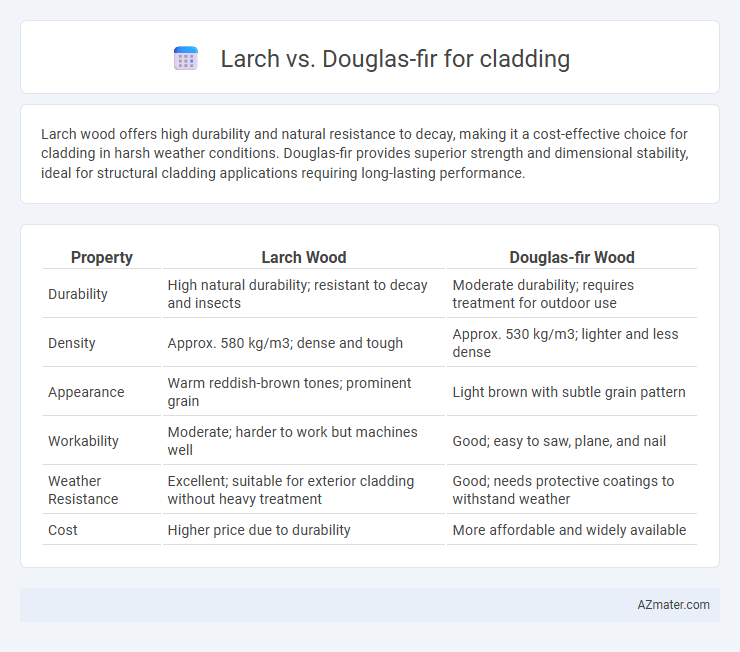Larch wood offers high durability and natural resistance to decay, making it a cost-effective choice for cladding in harsh weather conditions. Douglas-fir provides superior strength and dimensional stability, ideal for structural cladding applications requiring long-lasting performance.
Table of Comparison
| Property | Larch Wood | Douglas-fir Wood |
|---|---|---|
| Durability | High natural durability; resistant to decay and insects | Moderate durability; requires treatment for outdoor use |
| Density | Approx. 580 kg/m3; dense and tough | Approx. 530 kg/m3; lighter and less dense |
| Appearance | Warm reddish-brown tones; prominent grain | Light brown with subtle grain pattern |
| Workability | Moderate; harder to work but machines well | Good; easy to saw, plane, and nail |
| Weather Resistance | Excellent; suitable for exterior cladding without heavy treatment | Good; needs protective coatings to withstand weather |
| Cost | Higher price due to durability | More affordable and widely available |
Introduction to Larch and Douglas-fir as Cladding Materials
Larch wood offers exceptional durability and natural resistance to decay, making it a popular choice for exterior cladding in harsh climates. Douglas-fir, known for its strength and fine, straight grain, provides excellent structural stability and a smooth finish suitable for modern architectural designs. Both species deliver impressive weather resistance and aesthetic appeal, with larch lending a warm, rich tone while Douglas-fir presents a lighter, uniform appearance for diverse cladding applications.
Botanical Differences: Larch vs Douglas-fir
Larch (Larix spp.) is a deciduous conifer that sheds its needles seasonally, featuring a yellow to orange fall color, while Douglas-fir (Pseudotsuga menziesii) is an evergreen conifer retaining its needles year-round with a darker green hue. The wood of Larch is characterized by a higher resin content and greater natural durability, making it more resistant to decay and insect attack compared to the moderately durable Douglas-fir. Both species exhibit distinct growth rings; Larch shows pronounced resin canals aiding water resistance, whereas Douglas-fir's tight grain structure provides superior dimensional stability in cladding applications.
Durability and Weather Resistance Comparison
Larch wood offers exceptional natural durability and high resistance to rot and insect damage, making it a popular choice for cladding in harsh weather conditions. Douglas-fir provides strong dimensional stability with moderate decay resistance, often requiring additional treatments to enhance its weather performance. Both species perform well as exterior cladding, but larch generally outperforms Douglas-fir in long-term weather resistance and durability without extensive maintenance.
Aesthetic Qualities: Color, Grain, and Texture
Larch cladding features warm, golden-yellow hues with prominent resin canals that create a unique, knotty grain pattern, imparting a rustic, textured appearance ideal for natural or traditional designs. Douglas-fir offers a richer reddish-brown tone with a tighter, straighter grain and a smoother texture, lending a more refined and uniform look suitable for modern and architectural finishes. Both species provide excellent aesthetic versatility, but Larch brings a more dynamic, tactile surface while Douglas-fir emphasizes elegance and consistent coloration.
Workability and Installation Considerations
Larch wood offers excellent workability for cladding due to its moderate density and consistent grain, allowing smooth cutting and shaping with standard woodworking tools. Douglas-fir, while denser, provides robust structural strength but can be more challenging to machine, requiring sharper tools and increased effort during installation. Both species demand proper acclimatization to prevent warping, but Larch's natural durability and ease of fastening often result in faster installation times compared to Douglas-fir.
Cost Analysis: Larch vs Douglas-fir
Larch cladding generally offers a lower initial cost compared to Douglas-fir due to its wider availability and faster growth rates, resulting in more affordable lumber prices. Douglas-fir, while more expensive upfront, provides longer-lasting durability and superior resistance to weathering, potentially reducing long-term maintenance expenses. Evaluating total lifecycle costs, Larch may be more budget-friendly initially, but Douglas-fir could offer better value in high-exposure environments due to its enhanced structural properties.
Sustainability and Environmental Impact
Larch and Douglas-fir both offer sustainable options for cladding, with larch known for its natural durability and resistance to decay, reducing the need for chemical treatments. Douglas-fir, sourced from responsibly managed forests certified by FSC or PEFC, provides a carbon-efficient solution thanks to its fast growth and high strength-to-weight ratio. Choosing either species supports low-impact construction practices, but larch's longevity and minimal maintenance often result in a lower overall environmental footprint.
Maintenance Requirements for Cladding
Larch cladding requires regular maintenance due to its high resin content, which can lead to uneven weathering and color changes, necessitating periodic sealing or staining to preserve durability and appearance. Douglas-fir offers superior dimensional stability and natural resistance to decay, resulting in lower maintenance needs and reduced frequency of treatments compared to larch. Both woods benefit from protective coatings, but Douglas-fir's tighter grain structure enhances resistance to moisture penetration, minimizing long-term upkeep efforts.
Performance in Different Climates
Larch cladding excels in wet, cold climates due to its natural durability and high resin content, which provides resistance to rot and insect damage. Douglas-fir performs well in temperate, moderate moisture conditions, offering strong dimensional stability and good resistance to decay when properly treated. Both woods require maintenance, but larch generally outperforms Douglas-fir in harsher, wetter environments.
Best Uses and Recommendations for Cladding Choices
Larch offers superior natural durability and resistance to decay, making it ideal for exterior cladding in harsh weather conditions and coastal areas, while its attractive grain adds aesthetic value. Douglas-fir is valued for its strength, dimensional stability, and smooth finish, suitable for structural cladding applications and finishes requiring paint or stain. For optimal cladding performance, choose larch for weather-exposed facades and Douglas-fir for projects emphasizing structural integrity and smooth surface treatments.

Infographic: Larch vs Douglas-fir for Cladding
 azmater.com
azmater.com